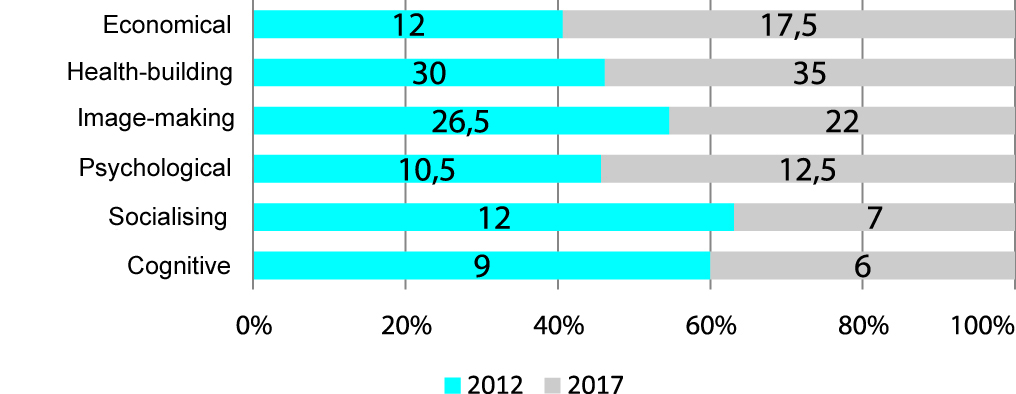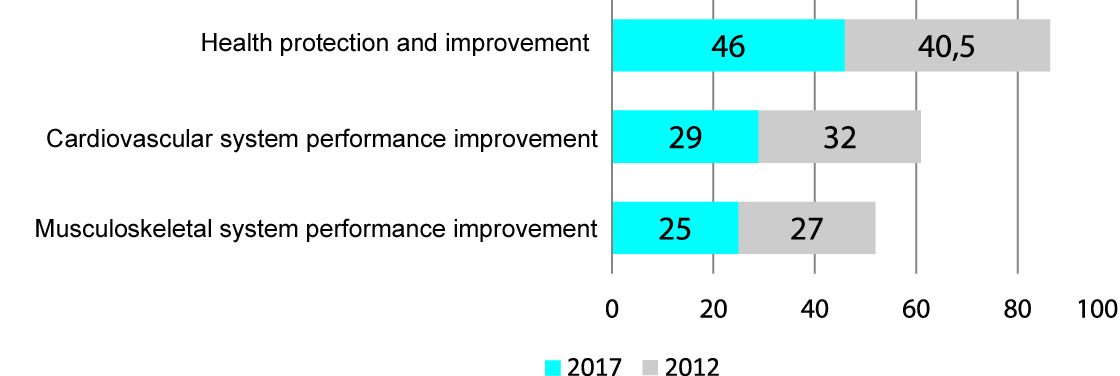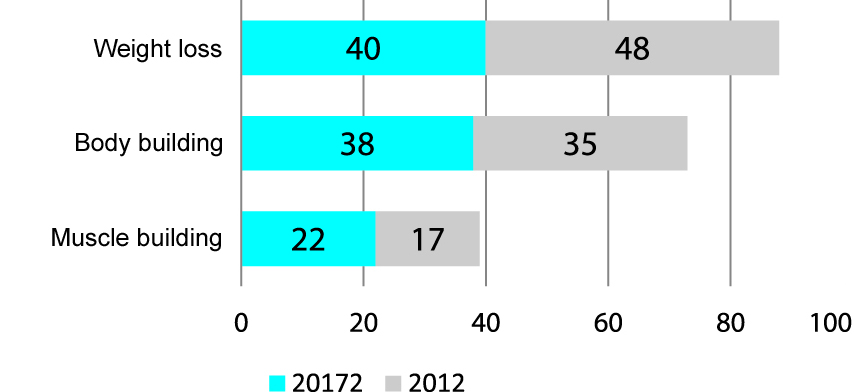Fitness industry clientele's needs and motivations in economic recession period
Фотографии:
ˑ:
PhD, Associate Professor V.V. Nasonov1
PhD, Professor P.G. Smirnov2
1Tyumen State University, Tyumen
2Tyumen Industrial University, Tyumen
Keywords: motivations for physical training, diversification, economy, sports, needs, interests, marketing, fitness industry.
Background. Progress of the market economy in our country is associated with reforms in the national physical culture and sports sector including commercial physical training and health services provided, among other business entities, by fitness clubs [1-4]. Their growing success is confirmed by the fact that more than 150 fitness clubs run their operations today in Tyumen [5]. However, fitness club services are still limited by a variety of problems and factors including:
- Shortage of knowledge and practical experience in the process actors for success in dynamic market situations;
- Imbalance of the demand and supply in the commercial physical training and sporting services they offer; and
- Still poor promotion of the commercial physical training and sporting services and next to no competency in the modern service marketing and promotion tools and methods.
For the last few years the above business promotion problems have been aggravated by a notable (12-14%) fall in the purchasing capacity of the available and potential clients due to the ongoing financial and economic crisis; and in this situation the club management has to look for new business diversification models [6]. Surveys of the potential clientele to find their needs and motivations for commercial physical training and health services may be applied as one of the most efficient solutions to the above problems, with the survey data, new knowledge and analyses giving grounds for revision of the corporate policies and practices including the service range and content.
Objective of the study was to analyse needs and motivations of the client groups/ segments on the market of commercial physical training and sports services provided by the local fitness industry. Fitness industry may be defined as the growing systemic health protection and improvement and sporting commercial services dominated by active and multisided physical practices.
Methods and structure of the study. Subject to the study performed in 2012-17 was the core clientele (n=800, including 368 men and 425 women) of 5 largest fitness centres that offer a wide range of physical training and health services to the Tyumen city residents. We applied content analyses, questionnaire surveys, retrospective data analyses and internet polls to obtain the study data. One of the core goals at this stage of the study was to classify the subjects into groups/ segments by their specific needs and motivations for the service to facilitate the service customisation with the relevant adjustments to the training programs.
Study results and discussion. For the purposes of our factor analysis, we first analysed the age structure of the clientele since the training programs, equipment and accessories, coaching and instruction services are largely age-specific. It was found that the clientele is dominated by 21-40 year-olds making up 67% of the total clientele including 35% of the 21-30 year-olds and 32% of the 31-40 year-olds, with the age structure being quite constant for the period under study. The adjacent age groups are notably smaller estimated at 8.5% of the 17-20 year-olds and 15.5% of the 41-50 year-olds. We believe that the latter groups shall be in top priority in the service promotion campaigns, with the junior group being the most promising for the reason that university students have been engaged in the mass trainings for the GTO Complex tests since 2017. The relevant training components need to be included in the range of the training services, and the business marketing teams shall address this group by special promotional actions, bonuses etc.
The subjects’ motivations for physical practices subject to the study may be basically classified as follows: socialising, cognitive, health-building, image-making, psychological (emotional) and economic ones: see Figure 1 hereunder.

Figure 1. Classified motivations for fitness-club services
We rated the economic motivations as the most affected by the ongoing economic crisis as highly dependent on the sagging income levels: in this group the motivations were found to fall by 60% and their impact on the fitness club attendance was found to grow from 11% to 20%. The image-making motivations were found to notably decrease as well that may be explained by the recent shift in the trainees’ needs towards health and psychological (emotional) agenda, plus staff reductions in the mid-level corporate management (attending fitness clubs).
The core and potential clients were found to give much more attention to the health protection and improvement needs that may be explained by the inflation processes on the one hand and the notable slow-down in the pensions growth process. The health motivations of the trainees may be classified into the following three components: see Figure 2.

Figure 2. Trainees’ health motivation components

Figure 3. Trainees’ image-making motivation components
The psychological motivation was found to include the following components (data of 2012 in brackets):
(1) stress control, distraction from everyday problems reported by 56% (49%) of the sample; and (2) positive emotions reported by 44% (51%) of the total.
The factor of cognitive motivations largely dependent on the club coaching team competency was found to include two components: (1) desire to learn more about healthy lifestyle, key athletic training methods and benefits of active health-building leisure-time practices – reported by 46% of the sample; and (2) mastering the right and efficient exercise performance techniques, acquire new skills and abilities and better control own body – reported by 54% of the sample.
The socialising motivations were found to be increasingly important nowadays versus the other motivation classes. Striving to better understand and analyse this motivation category, we classified it into the following components: (1) Need for communication with like-minded people; (2) Need for making new friends and acquaintances; (3) Growing respect and weight in the community; and (4) Growing self-confidence and self-esteem.
Furthermore, we found the socialising motivation being largely gender-specific and dominating in the female groups since 48% of the women attending the fitness clubs mention the need for communication with like-minded people; 23% report the need for making new friends and acquaintances; 15% expect growth of respect and weight in the community; and 14% give the top priority to the growing self-confidence and self-esteem as a result of the trainings.
Men’s socialising motivation structure was found much different from the above, with 40% reporting the growing self-confidence and self-esteem as a priority component; 32% appreciate the growing respect and weight in the community; 21% mention the need for communication with like-minded people; and only 7% report the need for making new friends and acquaintances.
It should be noted that for the last five years the respondents’ socialising motivation components were found to vary within the statistical error limits that means that these trends are quite constant.
Conclusion. The public demand for the fitness club services has been largely affected in the last few years by the ongoing financial and economic crisis with the purchasing power being on the fall and with the relevant changes in the needs and motivations for physical practices of the club clientele.
The above negative trend shall be responded by the content of the training services being revised with a special emphasis on every age group trainings for the GTO Complex tests supported by the relevant sporting lifestyle promotion campaigns – viewed as one of the key fields of the local fitness industry services diversification policy.
Health-building, image-making and economic motivations were found to be dominating in the current needs and motivations of the fitness industry clientele. As a result of the economic stagnation and sagging living standards, a considerable share of the national population gives special attention to health-building, economic and psychological (emotional) motivations at sacrifice of the socialising and cognitive motivations.
The sagging living standards were found to cause virtually no effect on the gender-specific preferences of the clients in the physical training and sporting services offered at fitness clubs.
References
- Artemev A.A., Morozova A.E. Platnye uslugi kak sposob uluchsheniya finansovogo sostoyaniya uchrezhdeniy fizkulturno-sportivnoy napravlennosti v usloviyakh krizisa [Paid services as a way to improve financial status of physical culture and sports institutions in crisis]. Mater. Vseros. nauch.-prakt. konf. molodykh uchenykh, aspirantov, magistrantov, soiskateley i studentov ‘Problemy sovershenstvovaniya fizicheskoy kultury, sporta i olimpizma’ [Proc. Rus. res.-pract. conf. young scientists, postgraduates, undergraduates, applicants and students ‘Problems of improvement of physical culture, sports and Olympism’]. Omsk: SSUPC publ., 2016, no. 1, pp. 248-255.
- Ivanova S.V., Manzheley I.V. Organizatsiya fizkulturno-sportivnoy raboty po mestu zhitelstva na munitsipalnom urovne [Organization of municipal domiciliary sports activity]. Teoriya i praktika fiz. kultury, 2013, no. 2, pp. 42-47.
- Ivanova S.V., Manzheley I.V. Fizkulturno-sportivnaya rabota s naseleniem: sredovy podhod [Physical culture and sports activities with population: environmental approach]. Tyumen, 2015, 244 p.
- Kosogortsev V.I. Podkhody k klassifikatsii uslug fizkulturno-sportivnykh organizatsiy [Services provided by physical culture and sports organizations: classification approaches]. Rossiyskoe predprinimatelstvo, 2016, no. 4, pp. 573-584.
- Smirnov P.G., Smirnov P.P. Marketingovaya politika fizkulturno-sportivnykh organizatsiy v usloviyakh finansovo-ekonomicheskogo krizisa [Marketing policy of physical culture and sports organizations under financial and economic crisis]. Mater. Mezhdunar. nauch.-prakt. konf. ‘Vospitatelno-patrioticheskaya i fizkulturno-sportivnaya deyatelnost v vuzakh: innovatsii v reshenii aktualnykh problem’ [Proc. Intern. res.-pract. conf. ‘Educational and patriotic and physical education and sports activities in universities: innovation in solving pressing problems’], Tyumen: TIU publ., 2017, pp. 267-271.
- Khametova N.G., Kurmaleeva R.R. Rol marketinga v privlechenii klientov v fitnes klub [Role of marketing in attracting clients to fitness club]. Sb. st. Mezhdunar. nauch.-prakt. konf. ‘Fundamentalnye problemy nauki’ [Proc. Intern. res.-pract. conf. "Fundamental problems of science"]. Ufa: Aeterna publ., 2016, pp. 295-298.
Corresponding author: Vladimir-nasonov00@rambler.ru
Abstract
Objective of the study was to analyse needs and motivations of potential client groups/ segments on the market of physical training and sports services provided by fitness clubs to customise the services to the actual identified and classified needs and agendas. The study team analysed the available literature on the subject to classify motivations for physical practices and found that a prudent marketing strategy is needed to design the physical training and health services with a top priority to potential clients’ interests, needs and motivations. The potential clientele to the physical training and health services classified into age and gender groups was surveyed to find and analyse the age- and gender-specific group motivations, factors of influence on them and the relevant key values. We believe that the study data and findings may be helpful in the efforts to promote physical education and health services in different consumer groups and are beneficial for the relevant commercial physical training and health entities. The study data made it possible to design and offer a set of management and marketing policy options for fitness clubs to (a) lure potential clients; and (b) prevent outflow of the clientele.



